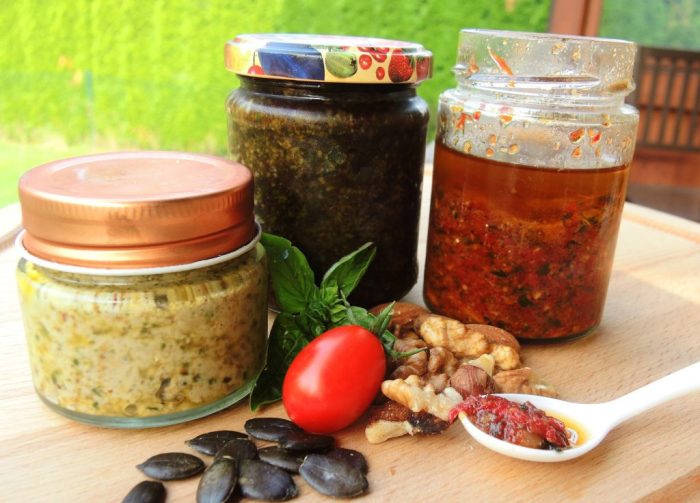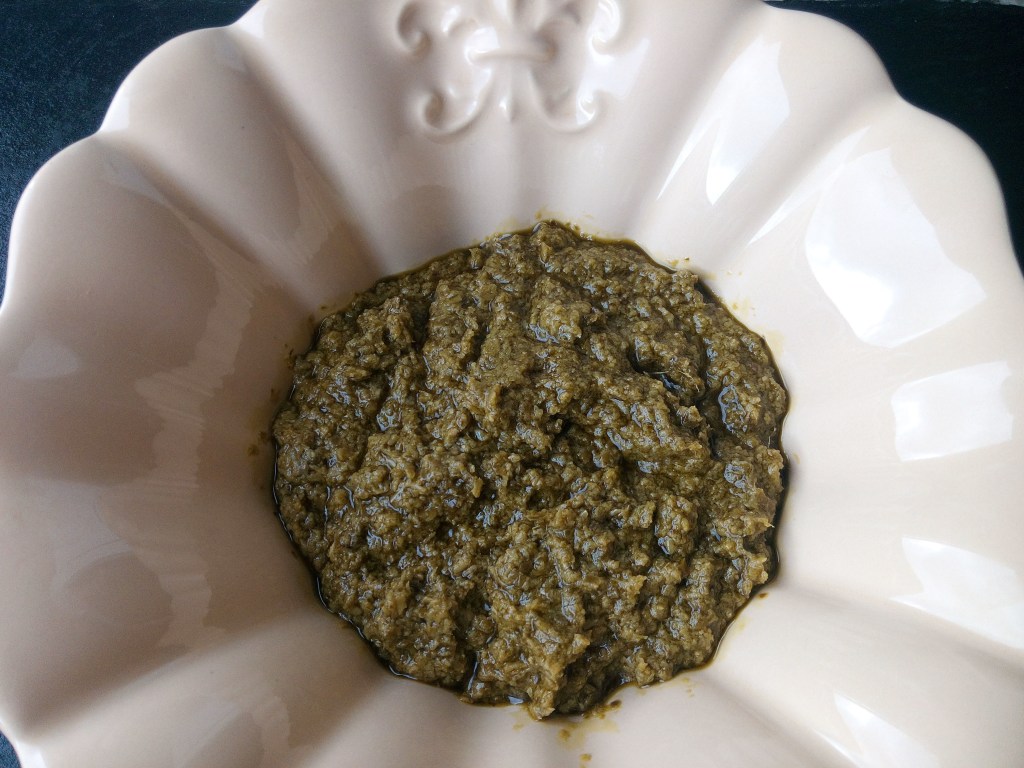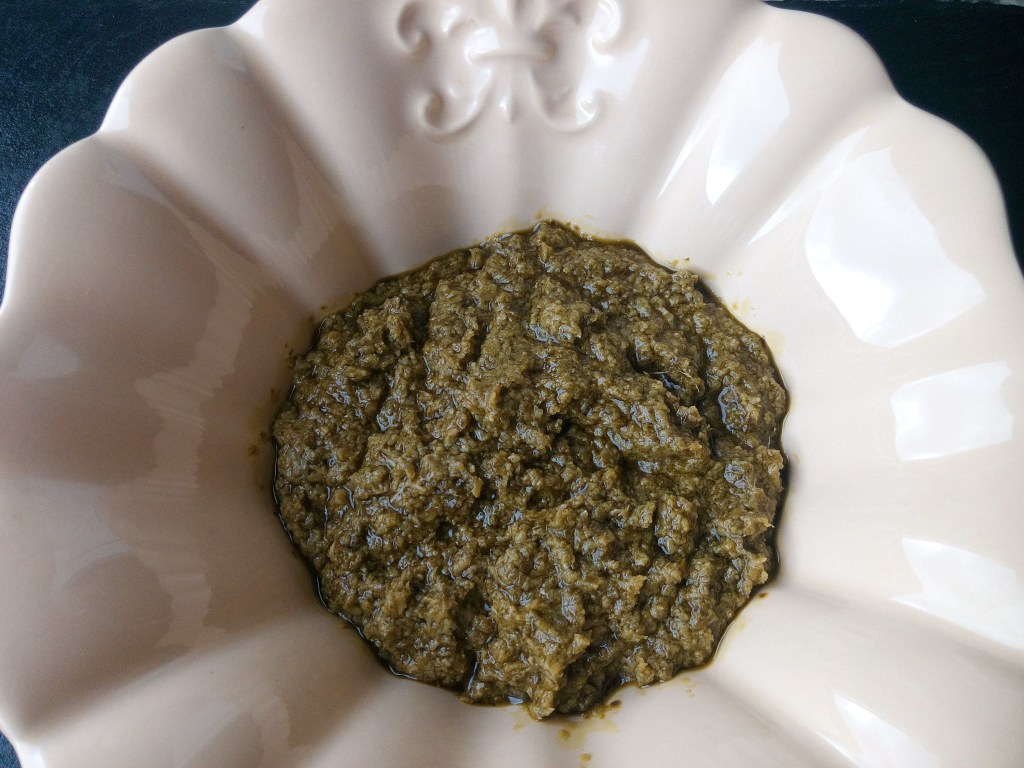DIY pesto is a culinary adventure that unlocks a world of fresh, vibrant flavors. Beyond the convenience of store-bought jars, homemade pesto offers a chance to personalize your taste with the freshest ingredients, controlling the intensity of herbs, the crunch of nuts, and the tang of cheese.
From classic basil pesto to more adventurous variations like sun-dried tomato or pistachio pesto, the possibilities are endless. Whether you’re drizzling it over pasta, topping grilled chicken, or adding a punch of flavor to a simple salad, homemade pesto transforms everyday dishes into culinary delights.
Techniques for Making Pesto
Pesto, a vibrant sauce made from fresh basil, pine nuts, garlic, Parmesan cheese, and olive oil, adds a burst of flavor to pasta, sandwiches, and even pizzas. While the basic ingredients remain the same, the method of preparation can significantly impact the texture and flavor of your pesto. Let’s explore the different techniques for making pesto, their advantages, and tips for achieving the perfect consistency.
Using a Mortar and Pestle
This traditional method is considered the best for achieving a truly authentic pesto. The gentle grinding action of the mortar and pestle releases the essential oils from the basil, creating a fragrant and flavorful pesto.
- Steps
- Start by adding the garlic and a pinch of salt to the mortar. Grind them together until they form a paste.
- Add the basil leaves, a few at a time, and continue grinding until they are finely chopped and release their aromatic oils.
- Gradually add the pine nuts, grinding them until they are finely chopped and evenly distributed.
- Add the Parmesan cheese and continue grinding until the mixture is well combined.
- Finally, drizzle in the olive oil, mixing it thoroughly until the pesto reaches the desired consistency.
- Pros
- Produces a smooth, flavorful pesto with a well-developed texture.
- Allows for greater control over the consistency and texture of the pesto.
- Preserves the natural flavors and aromas of the ingredients.
- Cons
- Can be time-consuming and labor-intensive, especially for larger batches.
- May require some practice to achieve the desired consistency.
Tip: To ensure a smooth and consistent pesto, use a high-quality mortar and pestle made from heavy materials like granite or marble.
Using a Food Processor
A food processor offers a quicker and more efficient way to make pesto. However, it can be challenging to control the consistency and prevent over-processing, which can result in a pasty texture.
- Steps
- Add the garlic, basil leaves, pine nuts, and Parmesan cheese to the food processor.
- Pulse the ingredients until they are finely chopped and well combined.
- With the motor running, slowly drizzle in the olive oil until the pesto reaches the desired consistency.
- Pros
- Saves time and effort compared to using a mortar and pestle.
- Suitable for larger batches of pesto.
- Cons
- Can over-process the ingredients, resulting in a pasty texture.
- May not release the full flavor of the basil compared to a mortar and pestle.
Tip: Pulse the ingredients in short bursts to avoid over-processing and maintain a vibrant green color.
Using a Blender
A blender can also be used to make pesto, but it’s important to be mindful of the blending time to avoid overheating the ingredients and creating a bitter taste.
- Steps
- Add the garlic, basil leaves, pine nuts, and Parmesan cheese to the blender.
- Blend on low speed until the ingredients are finely chopped and well combined.
- With the blender running, slowly drizzle in the olive oil until the pesto reaches the desired consistency.
- Pros
- A convenient option for making pesto in smaller quantities.
- Cons
- Can overheat the ingredients, leading to a bitter taste.
- May not produce a smooth and consistent texture compared to a mortar and pestle or food processor.
Tip: Use a high-speed blender and blend in short bursts to avoid overheating the ingredients.
Pesto Variations and Flavor Profiles

Pesto is a versatile sauce that can be adapted to create a wide range of flavors. By experimenting with different herbs, nuts, cheeses, and spices, you can create unique and delicious pesto variations that complement various dishes.
Pesto Variations
Here’s a table showcasing popular pesto variations, highlighting their key ingredients and flavor profiles:
| Variation | Key Ingredients | Flavor Profile |
|---|---|---|
| Classic Basil Pesto | Basil, pine nuts, Parmesan cheese, garlic, olive oil, salt, pepper | Earthy, nutty, savory, with a bright, herbaceous flavor |
| Sun-Dried Tomato Pesto | Sun-dried tomatoes, garlic, pine nuts, olive oil, Parmesan cheese, basil | Sweet, tangy, savory, with a hint of umami |
| Pistachio Pesto | Pistachios, Parmesan cheese, garlic, olive oil, basil, lemon juice | Rich, nutty, slightly sweet, with a bright, citrusy note |
| Arugula Pesto | Arugula, pine nuts, Parmesan cheese, garlic, olive oil, lemon juice | Peppery, slightly bitter, with a refreshing, citrusy flavor |
| Walnut Pesto | Walnuts, Parmesan cheese, garlic, olive oil, basil, lemon juice | Nutty, earthy, with a slightly sweet and tangy flavor |
| Spinach Pesto | Spinach, pine nuts, Parmesan cheese, garlic, olive oil, lemon juice | Mild, earthy, with a slightly sweet and tangy flavor |
Using Different Ingredients
Herbs
Different herbs contribute unique flavors to pesto. For example, using parsley instead of basil creates a milder, more grassy flavor. Mint adds a refreshing, cool flavor, while cilantro adds a bright, citrusy note.
Nuts
Nuts provide a nutty, earthy flavor and texture to pesto. You can substitute pine nuts with other nuts like walnuts, almonds, or cashews. Walnuts offer a richer, earthier flavor, while almonds provide a slightly sweet, buttery flavor.
Cheeses
Cheese adds a savory, umami flavor and creaminess to pesto. Parmesan cheese is a classic choice, but you can also use other hard cheeses like Pecorino Romano or Asiago.
Spices
Spices can be used to enhance the flavor profile of pesto. Red pepper flakes add a touch of heat, while a pinch of cumin or coriander can create a more complex flavor.
Recipes for Popular Pesto Variations
Sun-Dried Tomato Pesto
This pesto variation is perfect for adding a burst of flavor to pasta dishes, sandwiches, or pizzas.
Ingredients:
* 1 cup sun-dried tomatoes, packed in oil, drained
* 1/4 cup pine nuts
* 2 cloves garlic, minced
* 1/4 cup olive oil
* 1/4 cup grated Parmesan cheese
* 1/4 cup fresh basil leaves
* Salt and pepper to taste
Instructions:
1. Combine all ingredients in a food processor and blend until smooth.
2. Season with salt and pepper to taste.
3. Serve immediately or store in an airtight container in the refrigerator for up to 5 days.
Pistachio Pesto
This pesto variation is a delicious and vibrant addition to pasta, grilled chicken, or fish.
Ingredients:
* 1 cup pistachios, toasted
* 1/4 cup Parmesan cheese, grated
* 2 cloves garlic, minced
* 1/4 cup olive oil
* 1/4 cup fresh basil leaves
* 1 tablespoon lemon juice
* Salt and pepper to taste
Instructions:
1. Combine all ingredients in a food processor and blend until smooth.
2. Season with salt and pepper to taste.
3. Serve immediately or store in an airtight container in the refrigerator for up to 5 days.
Arugula Pesto
This pesto variation is a refreshing and flavorful addition to pasta, salads, or sandwiches.
Ingredients:
* 1 cup arugula
* 1/4 cup pine nuts
* 2 cloves garlic, minced
* 1/4 cup olive oil
* 1/4 cup grated Parmesan cheese
* 1 tablespoon lemon juice
* Salt and pepper to taste
Instructions:
1. Combine all ingredients in a food processor and blend until smooth.
2. Season with salt and pepper to taste.
3. Serve immediately or store in an airtight container in the refrigerator for up to 5 days.
Creative Pesto Applications: Diy Pesto

Pesto, traditionally a vibrant sauce for pasta, offers a world of culinary possibilities beyond the classic pairing. Its bold, herbaceous flavor and creamy texture make it a versatile ingredient that can elevate various dishes. Let’s explore how pesto can transform your culinary creations.
Pesto Grilled Chicken
Pesto grilled chicken is a quick and flavorful weeknight meal. The pesto’s herbaceousness complements the chicken’s savory notes, creating a satisfying combination. You can marinate the chicken in pesto for a few hours or simply brush it on before grilling. Here’s a simple recipe:
Ingredients:
* 1 pound boneless, skinless chicken breasts
* 1/2 cup pesto
* Salt and pepper to taste
Instructions:
1. Combine pesto, salt, and pepper in a bowl.
2. Add chicken breasts and coat thoroughly in the pesto mixture.
3. Grill chicken over medium heat for 5-7 minutes per side, or until cooked through.
Pesto Pizza
Pesto pizza is a delightful variation on the classic. The pesto provides a fresh, herbaceous base for toppings like mozzarella, tomatoes, and roasted vegetables. You can use pre-made pizza dough or create your own.
Ingredients:
* 1 pizza dough
* 1/2 cup pesto
* 1 cup shredded mozzarella cheese
* 1/2 cup cherry tomatoes, halved
* 1/4 cup sliced red onion
* 1/4 cup fresh basil leaves
Instructions:
1. Preheat oven to 450 degrees F (232 degrees C).
2. Spread pesto evenly over the pizza dough.
3. Top with mozzarella cheese, cherry tomatoes, red onion, and basil leaves.
4. Bake for 12-15 minutes, or until crust is golden brown and cheese is melted.
Pesto Sandwiches
Pesto sandwiches offer a flavorful and satisfying lunch or snack. The pesto adds a burst of freshness to grilled chicken, roasted vegetables, or even just a simple cheese and tomato combination. You can use crusty bread or your favorite sandwich bread.
Ingredients:
* 2 slices of bread
* 2 tablespoons pesto
* 1/4 cup sliced mozzarella cheese
* 1/4 cup sliced tomatoes
* 1/4 cup fresh spinach leaves
Instructions:
1. Spread pesto evenly on both slices of bread.
2. Top one slice with mozzarella cheese, tomatoes, and spinach leaves.
3. Place the other slice of bread on top and enjoy.
Pesto Dips
Pesto can be transformed into a delicious dip for vegetables, crackers, or chips. Simply combine pesto with cream cheese, sour cream, or yogurt for a creamy and flavorful dip. You can also add chopped nuts, sun-dried tomatoes, or other herbs for additional flavor.
Ingredients:
* 1/2 cup pesto
* 4 ounces cream cheese, softened
* 1/4 cup chopped walnuts
* 1/4 cup grated Parmesan cheese
Instructions:
1. Combine pesto, cream cheese, walnuts, and Parmesan cheese in a bowl.
2. Mix well until smooth.
3. Serve with your favorite vegetables, crackers, or chips.
Pesto’s Nutritional Value
Pesto, a vibrant sauce originating from Genoa, Italy, is not just a culinary delight but also a nutritional powerhouse. Its base of fresh basil, olive oil, pine nuts, garlic, and Parmesan cheese offers a medley of vitamins, minerals, and antioxidants, contributing to a healthy and flavorful diet.
Nutritional Benefits of Pesto, Diy pesto
Pesto is rich in nutrients that provide numerous health benefits.
- Vitamins: Pesto is a good source of vitamins A, C, and K. Vitamin A, found in basil, is crucial for vision, skin health, and immune function. Vitamin C, abundant in basil and garlic, acts as an antioxidant and supports collagen production. Vitamin K, present in basil and pine nuts, plays a vital role in blood clotting and bone health.
- Minerals: Pesto contains essential minerals like potassium, iron, and magnesium. Potassium, found in basil and garlic, helps regulate blood pressure. Iron, present in basil and pine nuts, is essential for red blood cell production. Magnesium, abundant in pine nuts and Parmesan cheese, supports muscle function and bone health.
- Antioxidants: Pesto is rich in antioxidants, particularly flavonoids, found in basil and garlic. Antioxidants help protect cells from damage caused by free radicals, reducing the risk of chronic diseases.
Health Benefits of Pesto
The nutritional profile of pesto translates into various health benefits.
- Heart Health: The monounsaturated fats in olive oil, a key ingredient in pesto, can help lower LDL (bad) cholesterol levels and raise HDL (good) cholesterol levels, promoting heart health.
- Inflammation Reduction: The antioxidants in pesto, especially those from basil and garlic, possess anti-inflammatory properties, potentially reducing inflammation throughout the body.
- Immune Boost: The vitamins and minerals in pesto, particularly vitamin C from basil and garlic, support the immune system, helping the body fight off infections.
Making Pesto Even Healthier
To maximize the nutritional value of your pesto, consider these tips:
- Use Fresh Ingredients: Opt for fresh, high-quality ingredients, especially basil, which is the foundation of pesto’s flavor and nutritional value.
- Reduce Salt: Parmesan cheese can be high in sodium. Consider using less cheese or opting for a low-sodium variety.
- Choose Healthy Fats: Use extra virgin olive oil, known for its health benefits, instead of other oils.
- Experiment with Nuts: Replace pine nuts with other nuts like walnuts or almonds, which offer different nutritional profiles and flavors.
With a little effort and the right ingredients, you can create a symphony of flavors with DIY pesto. From the satisfying aroma of fresh herbs to the creamy texture and vibrant colors, homemade pesto is a testament to the joy of culinary creativity. So, grab your mortar and pestle, your food processor, or your blender, and embark on a delicious journey of flavor with your own homemade pesto.
Making your own pesto is a great way to add fresh flavor to your meals, and it’s surprisingly easy! You can experiment with different herbs and nuts to find your perfect combination. Speaking of DIY projects, you can also make your own mosquito repellent using natural ingredients, like citronella and lavender. Check out this guide for some simple recipes.
Once you’ve got your DIY mosquito repellent sorted, you can enjoy your delicious pesto-topped pasta outside without the pesky bugs!

